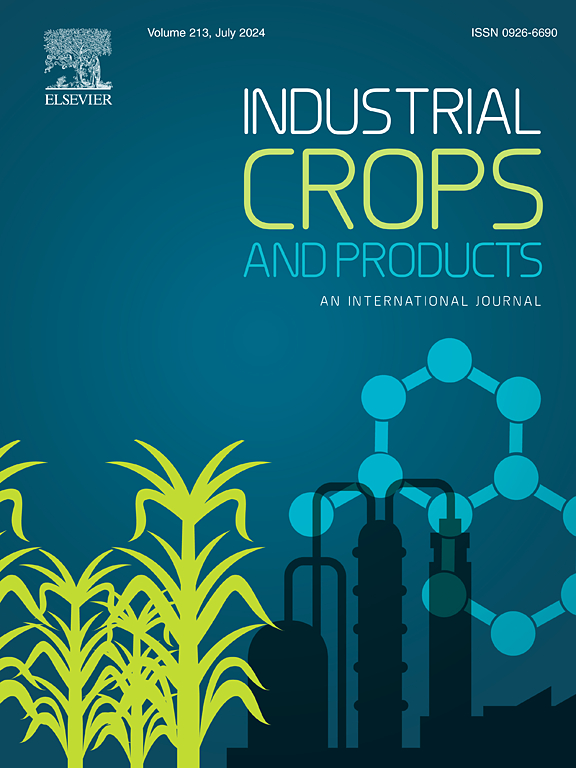A novel organic-inorganic composite flame-retardant coating with excellent compatibility provides superior flame retardancy and smoke suppression for wood
IF 5.6
1区 农林科学
Q1 AGRICULTURAL ENGINEERING
引用次数: 0
Abstract
Wood is a sustainable biomass material, valued for its renewability and environmental friendliness. The intrinsic flammability of wood can restrict its functional applications. The application of flame retardant coatings represents an efficient strategy to enhance the fire retardancy profiles of wood. However, currently used inorganic flame retardants with organic acrylic emulsion (AE) suffer from easy caking and reduced flame retardancy. A novel organic-inorganic CaAl-AA-LDH@AE composite flame retardant coating system based on wood was developed using environmentally friendly and highly thermally stable calcium-aluminium-type layered double hydroxide (CaAl-LDH) as the flame retardant. The successful synthesis of the organic-inorganic CaAl-AA-LDH composite flame retardant was confirmed by characterisation analytical techniques. The results of the surface roughness testing demonstrated that the average values of surface roughness (Ra) and irregularity height (Rz) for the organic-inorganic composite flame retardant paint exhibited notable reductions of 57.91 % and 54.72 %, respectively, compared with the unmodified flame retardant paint. The excellent compatibility of the organic-inorganic CaAl-AA-LDH in organic acrylic coatings markedly enhances the overall aesthetic and flame retardant properties of composite flame retardant coating. The heat release rate (HRR) of the organic-inorganic composite flame-retardant coating treated wood was reduced by 56.21 % and 20.78 %, the total smoke production (TSP) was decreased by 49.69 % and 20.25 %, and the residue mass increased by 64.13 % and 16.20 %, compared to unflame retarded wood and wood treated with unmodified flame retardant coating, respect tively. The organic-inorganic CaAl-AA-LDH@AE composite flame-retardant coating exhibits favourable, compatibility and flame-retardant properties, contributing significantly to the sustainable development and application of wood-based materials.
一种新型的有机-无机复合阻燃涂料,具有优异的相容性,为木材提供了优异的阻燃性和抑烟性
木材是一种可持续的生物质材料,具有可再生性和环保性。木材固有的可燃性限制了其功能的应用。阻燃涂料的应用是提高木材防火性能的有效策略。然而,目前使用的有机丙烯酸乳液无机阻燃剂易结块,阻燃性降低。以环境友好、热稳定的钙铝型层状双氢氧化物(cal - ldh)为阻燃剂,研制了一种新型的以木材为基础的有机-无机CaAl-AA-LDH@AE复合阻燃涂料体系。通过表征分析技术证实了有机-无机CaAl-AA-LDH复合阻燃剂的成功合成。表面粗糙度测试结果表明,有机无机复合阻燃涂料的表面粗糙度Ra平均值和不规则度高度Rz平均值分别比未改性的阻燃涂料降低了57.91 %和54.72 %。有机-无机CaAl-AA-LDH在有机丙烯酸涂料中的良好相容性显著提高了复合阻燃涂料的整体美观性和阻燃性能。经有机-无机复合阻燃涂料处理的木材的放热率(HRR)比未阻燃木材和未改性阻燃涂料处理的木材分别降低了56.21 %和20.78 %,总产烟率(TSP)分别降低了49.69 %和20.25 %,残渣质量分别增加了64.13 %和16.20 %。有机-无机CaAl-AA-LDH@AE复合阻燃涂料具有良好的相容性和阻燃性能,为木基材料的可持续发展和应用做出了重要贡献。
本文章由计算机程序翻译,如有差异,请以英文原文为准。
求助全文
约1分钟内获得全文
求助全文
来源期刊

Industrial Crops and Products
农林科学-农业工程
CiteScore
9.50
自引率
8.50%
发文量
1518
审稿时长
43 days
期刊介绍:
Industrial Crops and Products is an International Journal publishing academic and industrial research on industrial (defined as non-food/non-feed) crops and products. Papers concern both crop-oriented and bio-based materials from crops-oriented research, and should be of interest to an international audience, hypothesis driven, and where comparisons are made statistics performed.
 求助内容:
求助内容: 应助结果提醒方式:
应助结果提醒方式:


